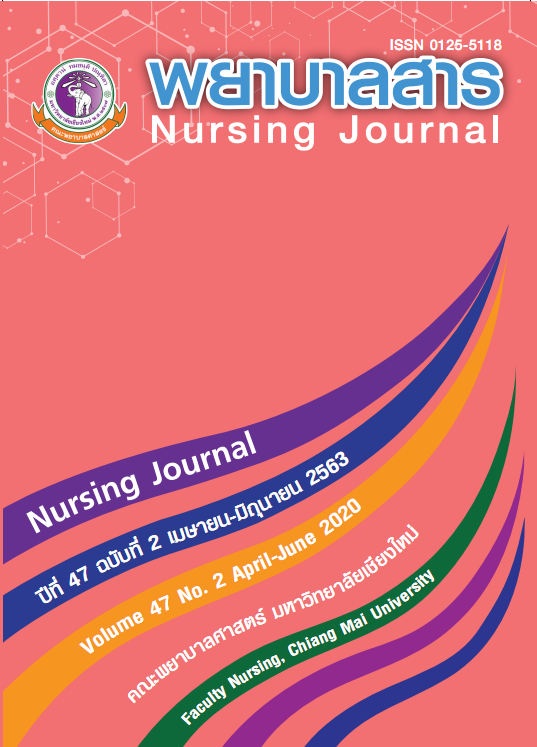Effects of Foot Reflexology on Labor Pain and Satisfaction among Adolescent Parturients
Keywords:
Foot reflexology, Labor pain, satisfaction, Adolescent parturientsAbstract
Labor pain causes discomfort and suffering. Adolescent parturients are less tolerant to pain than adults that cause them to not cope well with the pain. Foot reflexology is one method that may relieve labor pain. The purpose of this quasi-experimental research was to examine the effect of foot reflexology on labor pain and satisfaction among adolescent parturients. The subject selected following the inclusion criteria comprised of 44 adolescent parturients admitted at labor unit in Kamphaeng Phet hospital between April and December 2016, divided to an experimental group and control groups by random sampling of 22 participants per group. The participants in the experimental group received foot reflexology for twenty minutes at beginning of cervical dilatation of at least 4 cm. while participants in the control group received routine nursing care. The research instrument consisted of the foot reflexology plan. Data collection tools consisted of the Numeric Rating Pain Scales and Pain management satisfaction assessment form which the researchers adapted from Stahmer et al (1998). Data were analyzed using descriptive statistics, Friedman test and Mann Whitney U test.
Results of the study revealed that: the experimental group had an average mean score of labor pain in the post-test period straightway, one hour after the experiment and two hours statistically significant less than the control group (p <.001, p <.001 and p = .001), and the experimental group had an average mean score of satisfaction statistically significantly higher than the control group (p < .001)
References
Afilalo, M., & Tselios, C. (1996). Pain relief versus patient satisfaction. Annals of emergency medicine, 27 (4), 436-438.
Anderson, C., & McGuinness, T. M. (2008). Do teenage mothers ex perience childbirth as traumatic?. Journal of Psychosocial Nursing, 46( 4), 21-24.
Bender, T., Nagy, G., Barna, I., Tefner, I., K?das, ?., & G?her, P. (2007). The effect of physical therapy on beta-endorphin levels. European journal of applied physiology, 100 (4), 371-382.
Budin, W. (2007). Labor and childbirth. In S. S. Orshan (Ed.), Maternity, newborn, and women’s health nursing: Comprehensive care across the lifespan (pp. 583-672). Philadelphia: Lippincott.
Chumti, L. (2011). Effect of foot reflexology on stress reduction among adolescent mothers during the postpartum period (Master’s thesis, Khon Kaen University). (In Thai)
Cunningham, F. G., Leveno, K. J., Bloom, S. L., Spong, C. Y., Dashe, J. S., Hoffman, B. L., … Sheffield, J. S. (Eds.). (2014). Williams obstetrics. (24th ed.).New York: McGraw-Hill Education.
Dolatian, M., Hasanpour, A., Montazeri, S. H., Heshmat, R., & Majd, H. A. (2011). The effect of reflexology on pain intensity and duration of labor on primipar as. Iranian Red Crescent Medical Journal, 13 (7), 475-479.
Habanananda, T. (2004). Non-pharmacological pain relief in labour. Journal of the Medical Association of Thailand, 87(3), 194-202. (In Thai).
Jaloba, A. (2011). Healing the sole. Nursing Standard, 25(49), 18-19.
Jenabi, E., Mohajeran, M. H., & Torkamani, M. (2012). The effect of reflexology on relieving the
labor pain. The Iranian Journal of Obstetrics, Gynecology and Infertility, 14 (8), 43-48.
Kunz, B., & Kunz, K. (2005). The complete guide to foot reflexology (3rd ed.). NM: RRP press.
Lowdermilk, D. L. (2010). Labor and birth process. In D. L. Lowdermilk, S. E. Perry, & K. Cashion(Eds.). Maternity nursing (18 th ed.). Maryland Heights, MO: Mosby Elsevier.
Mackey, B. T. (2001). Massage therapy and reflexology awareness . Nursing Clinic of North America, 39 (1), 159-169.
Maneechotwong, N., Theerasopon, P., Muangpin, S., Jonrapun, R., Songjun, S., & Khumhirun, S. (2017). Effect of Foot Reflexology on Pain Reduction of the First Stage of Labor among Primiparous. Journal of Health Science, 26(3), 533-542. (In Thai)
Mirzaei, F., Kaviani, M., & Jafari, P. E. Y. M. A. N. (2010). Effect of foot reflexology on duration of labor and severity of first-stage labor pain. Iranian Journal of Obstetrics, Gynecology and Infertility, 13 (1), 27-32.
Rowlands, S., & Permezel, M. (1998). Physiology of pain in labour. Bailliere’s Clinical Obstetrics and Gynaecology, 12 (3), 347-362.
Sauls, D. J. (2010). Promoting a positive childbirth experience for adolescents. Journal of Obstetric, Gynecologic and Neonatal Nursing, 39, 703-712.
Shnol, H., Paul, N., & Belfer, I. (2014). Labor pain mechanisms. International Anesthesiology Clinic, 52 (3), 1-17.
Simkin, P., & Bolding, A. (2004). Update on non-pharmacologic approaches to relieve labor pain and prevent suffering. Journal of Midwifery & Women’s Health, 49(6), 489-504.
Stahmer, S. A., Shofer, F. S., Marino, A., Shepherd, S., & Abbuhl, S. (1998). Do quantitative changes in pain intensity correlate with pain relief and satis faction?. Academic Emergency Medicine, 5(9), 851-857.
Tiran, D. (2010). Reflexology in pregnancy and childbirth. Philadelphia: Elsevier.
World Health Organization [WHO]. (2003). Managing complications in pregnancy and child birth: A guide for midwives and doctors. Switzerland: Geneva.
Downloads
Published
How to Cite
Issue
Section
License
บทความที่ได้รับการตีพิมพ์เป็นลิขสิทธิ์ของวารสารพยาบาลสาร
ข้อความที่ปรากฏในบทความแต่ละเรื่องในวารสารวิชาการเล่มนี้เป็นความคิดเห็นส่วนตัวของผู้เขียนแต่ละท่านไม่เกี่ยวข้องกับมหาวิทยาลัยเชียงใหม่ และคณาจารย์ท่านอื่นๆในมหาวิทยาลัยฯ แต่อย่างใด ความรับผิดชอบองค์ประกอบทั้งหมดของบทความแต่ละเรื่องเป็นของผู้เขียนแต่ละท่าน หากมีความผิดพลาดใด ๆ ผู้เขียนแต่ละท่านจะรับผิดชอบบทความของตนเองแต่ผู้เดียว






